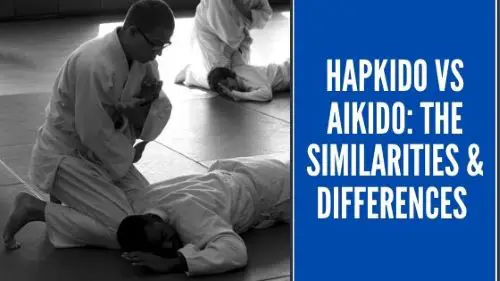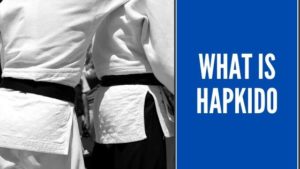Hapkido and Aikido are martial art disciplines that teach self-defense moves. While they may share certain similarities, some marked differences set them apart. We will look at both disciplines in our article below, and in a little more depth.
Hapkido; Facts and Background
Hapkido gained a lot of popularity in the 20th Century. Its place of origin is South Korea, and its creators are Seo Bok-Seob and Choi Yong-Sool.
According to the stories, during a leisurely stroll, Seo Bok saw a dozen people attack a young man. His initial thought was to jump in and help the victim, being a Judo black belt himself. However, before he could jump in, and to his amazement, the young man was able to fight back and send the assailants fleeing.
The victim, at this point identified as Choi Yong-Sool, was using the Daitô-ryû Aiki-jûjutsu fighting technique. A technique that many people now consider the parent of Hapkido. Seo Bok was eager to learn the technique and became Choi’s student.
They worked quite well together, and in 1959, they came up with the name Hapkido instead of the longer ‘hapki yu kwon sool’. You can breakdown the name Hapkido into ‘hap’ or harmony, ‘Ki’ a person’s mental spirit, and ‘do’ which stands for way or principal.
Related: What is Hapkido the Martial Arts
Aikido; Facts and Background
The founder of Aikido is Morihei Ueshiba, who was born in Southern Japan in the year 18k83. Morheir O-Sensei was a martial arts expert having studied the discipline from a very tender age.
He had skills in swordsmanship, sumo, staff and spear technique, as well as some styles of jujitsu. To him, martial art training was all about spirituality and personal purification.
He founded Aikido in the early parts of the 20th Century as a way of bringing back peace to the world. It is important to realize that during this time, Japan was experiencing more than its fair share of violent conflict.
The name Aikido comprises of 3 components; Ai, Ki, Do, which mean Japanese culture, spirit or breathe, and principles respectively. Anyone who uses Aikido for self-defense must take care not to injure the attacker. It is more about unifying, and not about aggression or violence. Aikido has been growing to international levels, and continues to spread its message of intention and noble philosophy.
Similarities between Hapkido and Aikido
- Date of Origin
Both Hapkido and Aikido can date their origin to the 20th Century. Hapkido dates back to the 1950s while Aikido in the late 1940s.
- Basic Principles
Both disciplines have their origin in the martial art discipline, Daito-Ryu Aiki Jujutsu. They both teach self-defense and how to protect yourself from an aggressor. Both disciplines encourage the use of the opponent’s energy and aggression instead of yours. In this way, you can use their momentum to their disadvantage during an attack.
Their basic tenets are “the way of the spirit or the way of the unifying life energy.
- Fighting Techniques
Both Hapkido and Aikido focus on redirecting attacks using the least resistance. The focus is not on aggressive response to attacks like you find in other martial art disciplines.
The main idea is to throw the opponent off-balance, then use tactics such as takedowns, locks, and body throws, to overcome them.
Differences between Hapkido and Aikido
- Place of Origin
Hapkido has its origin in Korea while Aikido is from Japan
- Moves
Hapkido shares a lot of similarities with the more traditional Korean martial arts. You will, therefore, find that it incorporates a lot of kicking movements when you compare it to the Aikido.
You get to use arm locks, strikes, kicks, and weapons. You will learn about using soft and hard techniques for both defense and offense moves.
With Aikido, the focus is more on defense rather than offence. It teaches how to use locks and pressure on the joints of the opponent. There is also a great emphasis on flexibility. It discourages practitioners from being initiators of attacks. You must also take care not to injure your opponent.
While they share the same redirection technique, therein lies some differences. Aikido redirects energy away, while Hapkido will redirect the energy downwards or around the opponent.
You also get to use punches or kicks to bring down the assailant. You have the option of striking them once they are down. You can, for example, aim for their heads, ankles, and throats to finish them off. In this way, you totally subdue the opponent and make it impossible for them to get up again.
The Aikido technique for redirecting incorporates the use of large circular movements. Hapkido takes a snake-like approach when attacking.
- Spirituality
Ueshiba used martial arts as a way of spiritual and philosophical development. On the other hand, Choi did not introduce the concept of spirituality into the discipline. He was more concerned with perfecting Hapkido using grappling and striking techniques to subdue the other party.
- Training
Hapkido and Aikido do share similarities with regards to some of the content they will teach the students. They both teach different techniques and tactics that are important in different situations. Hapkido, however, is more about the method than the inclusion of the spiritual concepts.
Aikido students, on the other hand, spend a lot of time learning so much more than fighting techniques. Some of the subjects they must take include philosophy, life principles, and etiquette.
Students also come out of the lessons knowing how to read the opponent’s mind. They also learn how to perform with confidence, and most importantly, respect their partners. They will also learn breathing techniques, which typically occurs before and after every lesson for 5 minutes.
Hapkido and Aikido are both excellent self-defense techniques. Unlike the more traditional forms of martial arts, the emphasis is not on violence or aggression. The aim is to use the opponent’s aggression to subdue them.
The main difference between the two is that Hapkido has more moves than Aikido, and encourages the use of weapons. There is an emphasis on kicks to destabilize your opponent. Aikido, on the other hand, is more spiritual in its outlook and focuses more on unifying rather than causing injury.






